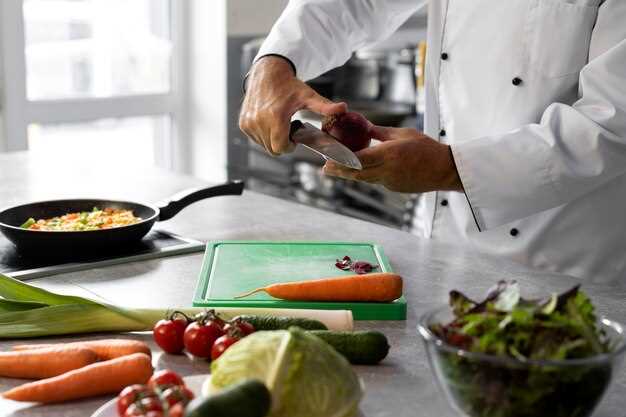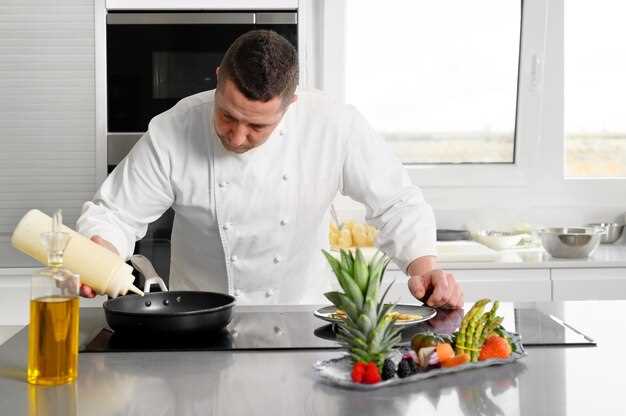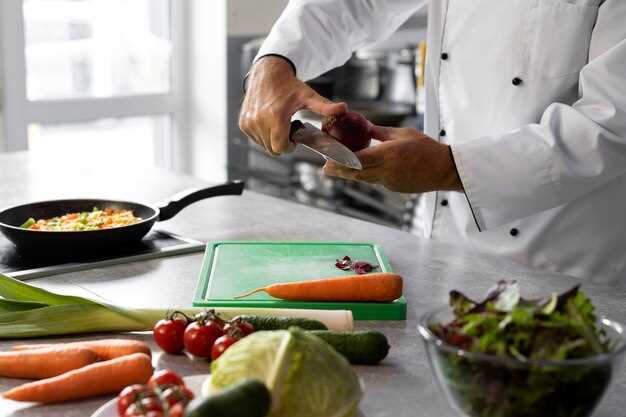Salt your ingredients from the start. This simple yet powerful advice can completely transform your cooking routine. Using salt early in the cooking process allows the flavors to develop fully, creating a more balanced and delightful dish. Start by seasoning meats and vegetables before cooking to ensure even distribution and enhanced taste.
Master the art of knife skills. Professional chefs emphasize the importance of proper knife handling, as it not only speeds up the preparation process but also improves the presentation of your dishes. Learning basic cuts like julienne, dice, and chiffonade can significantly enhance your cooking. Ensure your knives are sharp and comfortable to handle, as this increases efficiency and safety in the kitchen.
Focus on temperature control. Understanding the importance of heat can make or break a dish. High heat is perfect for searing meats and achieving crisp textures, while a gentle simmer is ideal for developing complex flavors in soups and sauces. Invest in a good thermometer to monitor temperatures precisely when cooking meats, ensuring they are both safe to eat and ideally tender.
Utilize fresh herbs and spices. They offer an unparalleled depth of flavor that dried counterparts often lack. Incorporate fresh basil, parsley, and cilantro to brighten dishes or use rosemary and thyme for a more earthy aroma. Grating spices like nutmeg or cinnamon directly into your dishes can introduce a more robust taste profile.
These practical and authentic chef tips will undoubtedly enhance your culinary skills, bringing professional results into your home kitchen.
Mastering Basic Techniques

Focus on perfecting knife skills by consistently practicing cutting techniques such as julienne, chiffonade, and dicing. A well-honed ability to slice not only increases efficiency but also enhances presentation.
- Knife Selection: Choose the right knife for the task. A chef’s knife is ideal for most tasks, while a paring knife is better for smaller, more intricate cuts.
- Proper Grip: Hold the knife with a firm grip, applying pressure with your thumb and index finger on the blade to maintain control.
- Even Cuts: Aim for uniform cuts to ensure even cooking. Practice makes perfect, so take your time to develop precision.
Understanding heat control is pivotal for exceptional results. Different dishes require varying levels of heat for optimal texture and flavor.
- Sauté: Allow your pan to reach the desired temperature before adding ingredients. Heat oil until shimmering to avoid soggy food.
- Simmer: Maintain a gentle bubbling by reducing heat once boiling; this preserves tenderness in stews and sauces.
- Grill: Preheat your grill fully to sear meats and retain juiciness. Avoid frequent flipping; let the food develop a crust.
Seasoning food correctly can transform a dish, offering depth and complexity. Start with basic seasonings and herbs to build flavors progressively.
- Salt: Enhance flavor by seasoning at various stages of cooking. Use kosher salt for better control and distribution.
- Acidity: Brighten dishes with a squeeze of lemon or a splash of vinegar, especially when flavors seem flat.
- Herbs: Add fresh herbs at the end of cooking to maintain vibrancy, while dried herbs benefit from cooking to release their essence.
Practicing these foundational techniques will significantly improve cooking skills, increasing both speed and confidence in the kitchen.
How to Properly Season Your Dishes
Measure salt with precision rather than guesswork to ensure balanced flavor profiles. Use kosher or sea salt for more control due to their larger grains. Taste your dish as you cook and add seasoning gradually to avoid over-salting.
Balance your flavors by incorporating acidity through lemon juice or vinegar, which can brighten the dish and enhance other ingredients. Utilize fresh herbs such as basil, cilantro, or parsley at the end of cooking to add a burst of freshness.
Select freshly ground black pepper instead of pre-ground varieties for a more robust taste. Toast whole spices like cumin or coriander seeds before grinding to unlock their full aroma and complexity.
Main components requiring seasoning include proteins and starches. Season meats well before cooking to allow the salt to penetrate, enhancing taste and texture. For pasta, generously salt the boiling water to infuse the noodles with flavor throughout.
Experiment with seasoning blends and regional spices to add depth and character to familiar dishes. Consider making your own spice mixes to customize flavors to your personal preference.
Adjust seasoning for specific dietary needs or preferences without compromising taste by using herbs, spices, and low-sodium alternatives creatively to fill in for reduced salt content.
Explore methods for balancing flavors and deciding when to adjust seasoning during cooking.
Begin by tasting your dish frequently throughout the cooking process. Adjusting seasoning is a dynamic task that relies on constant monitoring and tasting. Consider starting with small amounts of salt and pepper, expanding to herbs and spices as your dish develops. A pinch of acid, like vinegar or lemon juice, can uplift other flavors and add a refreshing contrast to richer taste profiles.
Understand that sweetness can balance out acidity or spiciness. If your dish lacks depth, a small amount of sugar or honey can enhance overall harmony. On the other hand, if sweetness becomes overwhelming, a splash of citrus can bring it back into balance. Complement spicy elements with creamy or fatty components like coconut milk or yogurt to mellow the heat.
Fresh herbs can transform a dish at the end of cooking. Toss in basil, cilantro, or parsley right before serving for an aromatic boost. Aromatics such as garlic or onions can be adjusted earlier in the cooking process, adding layers of flavor that evolve with heat.
Consider the temperature and texture of your ingredients. The same spice may exhibit different intensity in a hot dish compared to a cold one. Pay attention to how textures interact; a creamy dish may benefit from a hint of crunch through toasted nuts or breadcrumbs.
Finally, trust your palate and be willing to experiment. If a flavor feels off, think about the balance between salty, sweet, sour, bitter, and umami. A balanced dish doesn’t mean every flavor is equal, but rather that they complement each other to create a cohesive experience. Follow these guidelines, and you’ll find adjusting flavors becomes an intuitive part of your cooking process.
Knife Skills: Chopping and Slicing Like a Pro
Focus on using the right knife for each task. A chef’s knife with an 8-10 inch blade is versatile and perfect for most vegetables and meats. For delicate tasks like peeling ginger or dicing small shallots, use a paring knife. Ensure your knives are sharp; a dull blade is more dangerous and less efficient.
Master the claw grip to protect your fingers. Tuck your fingertips under and use your knuckles as a guide for the blade. This technique not only enhances safety but also improves precision and speed.
Practice cutting techniques with consistent slices. For chopping, use a rocking motion with the tip of the knife anchored to the board, moving the blade in a forward and downward arc. For slicing, draw the knife back toward you, maintaining an even thickness throughout each piece.
Maintain a stable cutting surface by placing a damp towel under your chopping board. This prevents slipping and keeps your workspace safe and organized.
Embrace proper cleaning and storage of your knives. Wash them by hand immediately after use and store them in a knife block or magnetic strip to keep the blades sharp and free from damage.
Learn the fundamentals of using the right knife for the task and maintaining sharpness.
Choose the correct knife for each task. Use a chef’s knife for chopping vegetables and cutting meat, a paring knife for peeling and intricate work, and a bread knife for slicing through baked goods. Selecting the appropriate knife not only improves efficiency but also enhances safety.
Maintain sharpness with proper honing. Regularly hone your knives using a honing steel to keep the edge aligned. Hold the knife at a 20-degree angle and slide it down the steel, alternating sides. This routine ensures your knives remain sharp and ready for precise cuts.
Keep blades sharp by sharpening them routinely. Depending on usage, sharpen your knives every few months with a whetstone or an electric sharpener. A well-sharpened knife reduces effort and minimizes the risk of accidents, allowing for cleaner, more efficient cuts.
Ensure safety by storing knives correctly. Use a magnetic strip or a knife block to keep blades protected and edges sharp. Avoid storing them loosely in drawers, where they can become dull or cause injury.
Practice proper handling techniques. Grip the knife handle firmly, curl your fingers inward on the hand holding the food, and ensure a stable cutting surface. Proper technique prevents slips and maintains control over each slice.
By understanding these fundamentals, you’ll not only extend the life of your knives but also enhance your culinary experience through precision and safety.
The Art of Sautéing Vegetables
Begin with selecting fresh vegetables; choose seasonal varieties for the best flavor and texture. Cut them into uniform pieces to ensure even cooking. Heat your pan over medium-high heat, adding just enough oil to coat the bottom. Olive oil or a neutral oil like grapeseed work well for high temperatures. Allow the oil to shimmer before adding your vegetables; this prevents them from absorbing too much oil and getting soggy.
Introduce the vegetables in batches if necessary to avoid overcrowding the pan. Overcrowding traps steam, which can lead to steaming instead of proper sautéing. Stir the vegetables occasionally, giving them time to develop a caramelized surface. Season early with salt to draw out moisture, enhancing the flavors. To infuse extra aroma, add garlic or herbs like thyme during the last couple of minutes of cooking.
Consider the cooking time variations among different vegetables. Start with denser vegetables like carrots or broccoli, adding quicker-cooking ones like bell peppers or zucchini later. This layering technique ensures each piece is cooked to perfection. Once the vegetables are tender-crisp, finish with a splash of lemon juice or balsamic vinegar to elevate the flavors further.
Discover techniques for achieving perfect texture and flavor in your sautéed dishes.
- Control the Heat: Begin with a well-heated pan to ensure even cooking and prevent ingredients from sticking. Medium-high heat works best for most vegetables and proteins, allowing them to brown without burning.
- Avoid Overcrowding: Cook in batches if necessary to avoid reducing the pan temperature. Overcrowding results in steaming rather than sautéing, which can lead to soggy, unevenly cooked food.
- Timing is Key: Know the cooking time for each ingredient and add them to the pan in stages. Start with items that take longer to cook, like carrots or potatoes, before adding more delicate components such as leafy greens or herbs.
- Use High-Quality Fats: Choose oils or fats that cope well with high temperatures, such as grape seed oil, canola oil, or clarified butter. These options enhance flavor while ensuring a smooth cooking process.
- Season Strategically: Add salt and spices in layers throughout the cooking process to enhance the natural flavors of your ingredients. A final seasoning adjustment before serving will bring out the best taste profile.
- Finish with Freshness: Consider adding a splash of acidity, like lemon juice or vinegar, at the end of cooking to brighten the dish’s overall flavor. Fresh herbs or a touch of zest can also elevate the final result, providing a refreshing contrast to the rich, savory elements.
Understanding Cooking Temperatures and Times
Always use a reliable thermometer to check the doneness of meat. Aim for an internal temperature of 165°F for poultry and 145°F for beef and pork. Mastering this ensures both safety and flavor.
For vegetables, recognize that different types need varying times and temperatures. Roasting root vegetables like carrots at 400°F enhances their sweetness in about 25-30 minutes, while more delicate options like asparagus thrive at 375°F for a mere 10-15 minutes.
Baking demands precision. Preheat your oven thoroughly, and opt for the middle rack to promote even heat distribution. Set timers accurately; a deviation as small as 5 minutes can affect cake texture or cookie crispness significantly.
| Dish | Temperature (°F) | Time |
|---|---|---|
| Whole Chicken | 350 | 1.5-2 hours |
| Beef Roast | 325 | 20 minutes per pound |
| Salmon Filets | 400 | 12-15 minutes |
| Vegetable Medley | 375 | 20-25 minutes |
When grilling, patience is key. Let the grill heat up properly before placing food on it to achieve perfect sear marks and prevent sticking. Control the heat zones to enable simultaneous searing and slow cooking.
Recognize that timing adjusts with altitude; higher altitudes often require increased cooking time. Adjust accordingly to avoid undercooked or overly dry results. This awareness will transform your approach to cooking.
Find out how to avoid common pitfalls by recognizing different cooking stages.
Mastering the art of identifying various cooking stages is crucial. One pivotal trick is to utilize the senses. Observe changes in color, texture, and aroma to gauge progress. For instance, when sautéing onions, start with moderate heat. They start translucent, gradually turning golden brown. If you miss this phase, they’ll burn, affecting flavors.
Implement the use of a reliable meat thermometer. It ensures that proteins reach safe temperatures. Note these benchmarks:
| Protein | Ideal Internal Temperature |
|---|---|
| Poultry | 165°F (74°C) |
| Beef, Pork, Lamb | 145°F (63°C) |
| Ground Meat | 160°F (71°C) |
| Fish and Shellfish | 145°F (63°C) |
Recognize the stages of simmering versus boiling. Simmering involves small bubbles gently rising, perfect for soups and stews to extract flavors without overcooking. Boiling, characterized by rapid bubbles, suits pasta or blanching vegetables, but can toughen meats.
Adjust seasonings incrementally. During reduction, flavors concentrate. Taste frequently when sauces or soups are reducing to ensure balanced flavors without overwhelming any ingredient.
Understand the importance of resting meat. After cooking, rest period allows juices to redistribute, making it juicier. For steaks and larger cuts, a rest of 5-10 minutes can make all the difference.
Ultimately, becoming attuned to these subtle queues will enhance dishes significantly.
Maximizing Flavor and Presentation

Enhance your dish by balancing flavors. Use the classic combination of salt, acid, fat, and heat to create depth. Salt enhances other flavors; a squeeze of citrus or a splash of vinegar brightens the dish. Experiment with different oils for richness, and remember that the right amount of heat brings out unique qualities in each ingredient.
- Use Fresh Herbs: Add them at the end of cooking for a vibrant flavor without diminishing their freshness. Basil, cilantro, and parsley can elevate both taste and presentation.
- Layer Textures: Combine crisp, creamy, and crunchy elements to create a satisfying mouthfeel. Pair roasted nuts or seeds with silky dressings or sauces.
- Season at Every Stage: Continuous seasoning ensures balanced flavor. Taste frequently and adjust as needed to achieve the desired complexity.
For appealing presentation, focus on color and composition. Contrast vibrant ingredients to make dishes pop visually. Consider the size and shape of each component. Use negative space to highlight the focal point on the plate, and remember the importance of symmetry for an aesthetically pleasing arrangement.
- Plan Your Plate: Visualize your finished dish during preparation. Placement of each element should guide the diner’s experience smoothly from first bite to last.
- Height Adds Interest: Build your dish upwards for a dynamic look. Stack elements or use garnishes like microgreens to create visual layers.
- Choose the Right Dishware: Select plates that complement the food’s colors and enhance its impact. The right background can make all the difference in presentation.
By creatively combining flavor and presentation techniques, you can elevate any meal to a memorable dining experience.
Video:

30 Must Know Tips from a Professional Chef
30 Must Know Tips from a Professional Chef
Q&A:

How can I enhance the flavor of a dish without adding extra salt?
Professional chefs often recommend using herbs and spices to boost flavors naturally. Consider adding fresh herbs like basil or parsley at the end of cooking or using spices like cumin or paprika for a depth of flavor. Acidic ingredients like lemon juice or vinegar can also brighten up a dish without needing additional salt.
What is an effective way to prevent meat from becoming too dry during cooking?
One reliable method suggested by chefs is to marinate your meat before cooking. This process helps in tenderizing the meat and infusing it with flavor. Another tip is to use a meat thermometer to ensure it’s cooked correctly, preventing overcooking and loss of moisture.
What are some tips for making my vegetable stir-fry more impressive?
To make a vegetable stir-fry stand out, chefs often suggest cutting vegetables into uniform sizes to ensure even cooking. Use high heat and a wok for the best results, and add vegetables in stages based on their cooking time to maintain texture. Finish with a drizzle of sesame oil and a sprinkle of toasted sesame seeds for enhanced flavor.
How can I tell when pasta is cooked perfectly?
Chefs often use the term “al dente” to describe perfectly cooked pasta, which means it should still have a slight firmness when bitten. To check for doneness, taste the pasta a minute or two before the time indicated on the package. The perfect pasta will have a slight bite without any raw flavor.
What should I keep in mind when trying to cook the perfect steak?
First, let the steak reach room temperature before cooking. Season it generously with salt and pepper. Use a heavy pan to achieve a good sear with high heat and avoid moving the steak around too much. Allow the steak to rest after cooking to keep the juices inside, resulting in a juicier steak.
How can I make my dishes taste as good as those from a professional chef?
One of the key recommendations from professional chefs is to focus on using high-quality ingredients. Fresh, seasonal produce, as well as good-quality spices and oils, can make a significant difference in the flavor of your dishes. Additionally, mastering the basics of seasoning, particularly the use of salt at the right stages of cooking, can elevate the taste of your meals. Chefs also suggest tasting your food frequently as you cook, adjusting the seasonings and flavors gradually to achieve the desired taste. Experimenting with herbs and spices, and understanding how they complement each other, can also add depth and complexity to your cooking, aligning it closer to restaurant-quality dishes.
